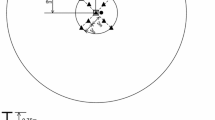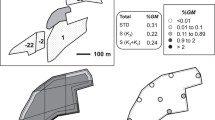Abstract
A common concern expressed about the commercial release of transgenic canola into cropping systems is the risks of unwanted gene flow between varieties. Experimental data is emerging that answers some of the theoretical questions that have been posed when considering gene flow on a landscape scale. This study developed models that utilise some of this published data in an attempt to quantify the spread of transgenes in a commercial farming system. The models, which included bootstrapping the empirical data and three mathematical simulations, were compared with each other and the published data. One of the mathematical models estimated average resistance frequency by imposing a Poisson distribution around the published mean value for a single transgenic field surrounded by conventional canola fields and the other two were derived from the theory that pollen flow decreased with distance in the form of a log decay curve. The predictions of all models suggested that the average frequency of resistance occurring from pollen flow in neighbouring canola fields, even when multiple transgenic fields are adjacent to the conventional fields, are likely to be below the current internationally accepted thresholds for contamination.
Similar content being viewed by others
References
Colbach N, Clermont-Dauphin C et al. (2001a) GeneSys: a model of the influence of cropping system on gene escape from herbicide tolerant rapeseed crops to rape volunteers. I. Temporal evolution of a population of rapeseed volunteers. Agric Ecosyst Environ 83: 235–253.
Colbach N, Clermont-Dauphin C et al. (2001b) GeneSys: a model of the influence of cropping system on gene escape from herbicide tolerant rapeseed crops to rape volunteers. II. Genetic exchanges among volunteer and cropped populations in a small region. Agric Ecosyst Environ 83: 255–270.
Lavigne C, Godelle B et al. (1996) A method to determine the mean pollen dispersal of individual plants growing within a large pollen source. Theor Appl Genet 93: 1319–1326.
Lavigne C, Klein EK et al. (1998) A pollen-dispersal experiment with transgenic oilseed rape. Estimation of the average pollen dispersal of an individual plant within a field. Theor Appl Genet 96: 886–896.
Maxwell BD, Roush ML et al. (1990) Predicting the evolution and dynamics of herbicide resistance in weed populations. Weed Technol 4: 2–13.
McCartney HA, Lacey ME (1991) Wind dispersal of pollen from crops of oilseed rape (Brassica napus L.). J Aerosol Sci 22: 467–477.
Rakow G, Woods DL (1987) Outcrossing in rape and mustard under Saskatchewan (Canada) prairie conditions. Can J Plant Sci 67: 147–152.
Richter O, Boettcher U et al. (2000) Modelling of spatial spread of herbicide resistance. Zeitschrift-fuer-Pflanzenkrankheiten-und-Pflanzenschutz. (Special Iss. 17): 329–336.
Rieger MA, Lamond M et al. (2002) Pollen-mediated movement of herbicide resistance between commercial canola fields. Science 296: 2386–2388.
Scheffler JA, Parkinson R et al. (1993) Frequency and distance of pollen dispersal from transgenic oilseed rape (Brassica napus). Transgenic Res 2: 356–364.
Scheffler JA, Parkinson R et al. (1995) Evaluating the effectiveness of isolation distances for field plots of oilseed rape (Brassica napus) using a herbicide-resistance transgene as a selectable marker. Plant Breed 114: 317–321.
Snow AA, Moran-Palma P (1997) Commercialization of transgenic plants: potential ecological risks. Bioscience 47: 86–96.
Squire GR (1999) Temperature and heterogeneity of emergence time in oilseed rape. Ann Appl Biol 135: 439–447.
Squire GR, Burn D et al. (1997) A model for the impact of herbicide tolerance on the performance of oilseed rape as a volunteer weed. Ann Appl Biol 131: 315–338.
Staniland BK, McVetty PBE et al. (2000). Effectiveness of border areas in confining the spread of transgenic Brassica napus pollen. Can J Plant Sci 80: 521–526.
Thompson CE, Squire G et al. (1999) Regional patterns of gene flow and its consequences for GM oilseed rape. Gene Flow and Agriculture. Relevance for Transgenic Crops. BCP Council, University of Keele, Staffordshire.
Author information
Authors and Affiliations
Corresponding author
Rights and permissions
About this article
Cite this article
Baker, J., Preston, C. Predicting the Spread of Herbicide Resistance in Australian Canola Fields. Transgenic Res 12, 731–737 (2003). https://doi.org/10.1023/B:TRAG.0000005147.04075.62
Issue Date:
DOI: https://doi.org/10.1023/B:TRAG.0000005147.04075.62




